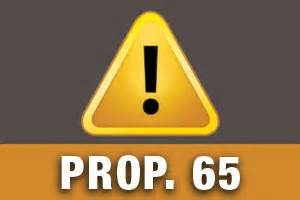By: Lee N. Smith
To download the PDF click here
 On September 25 we attended the Prop 65 Clearinghouse Annual Conference.
On September 25 we attended the Prop 65 Clearinghouse Annual Conference.
Most of the conference concerned how to comply with the new labeling regulations which are effective as of August 2018.
SUMMARY
A. In summary, there is new safe harbor language, a new website for consumers,and language which attempts to clarify liability as between manufacturers and retailers. Most significantly the new regulation asserts that for retailers to be liable actual knowledge must be imputed to them. This would not apply to companies that custom label products.
B. The new regulations go into effect on August 30, 2018, new labels can however be used before that time, if the business desires.
C. The language required by earlier Consent Judgments is considered within safe harbor, even in the older format.
D. The new labels contain language that requires the identification of at least one of the
Proposition 65 chemicals in the product, and identifies the public website.
E. The language for each of the types of warnings other than labeling (i.e. environmental vs.
product) has also changed but are not addressed here.
F. The emphasis in the regulations is for liability to the manufacturer for
Proposition 65; along with additional duties placed on vendors.
a. Product manufacturers have primary responsibility for warning.
b. The manufacturer can label product or provide notice to distributors/importers/retailers or
sellers that a product may cause an exposure to a listed chemical.
c. Provide warning signs, materials (unless they make other arrangements via contract) to
retailers.
d. The retailers must have actual knowledge of the chemicals to be liable.
G. Labeling
a. Safe Harbor Content and Methods
i. “This product contains [specific chemical]”
ii. “This product can expose you to [specific chemical]”
iii. The name of at least one chemical in the warning.
iv. Named chemicals are those for which warning is being provided.
v. Warning symbol
vi. Provide non-English language warnings in certain situations.
H. Phase In Effective date of regulation: August 30, 2018.
I. Consumer products manufactured prior to the effective date will not require new warnings if they meet existing safe harbor requirements.
J. Court-approved warnings expressly recognized and considered “clear and reasonable” for parties to litigation.
K. Tailored Warnings; In Addition To The Specific Warnings Listed Above, The Code Has Modified The Warnings For The Following Categories:
a. Environmental Exposure
b. Occupational Exposure
c. Alcoholic Beverages
d. Food and Non-Alcoholic Beverages
e. Prescription Drug Exposure and Emergency Medical or Dental Care Exposure
f. Dental Care
g. Raw Wood Products
h. Furniture Products
i. Diesel Engines
j. Vehicles
k. Recreational Vessels
l. Enclosed Parking Facilities
m. Amusement Parks
n. Petroleum Products
o. Service Station and Vehicle Repair
p. Designated Smoking Areas
q. Exposure to Bisphenol A from Canned and Bottled Foods and Beverages
Established in 1994, Coleman & Horowitt is a state-wide law firm focused on delivering responsive and value driven service and preventive law. The firm represents businesses and their owners in matters involving transactions, litigation, agriculture and environmental regulation and litigation, intellectual property, real estate, estate planning and probate. The Firm has been recognized as a “Top Law Firm” (Martindale Hubbell) and a “Go-To” Law Firm (Corporate Counsel). From six offices in California (Fresno, Visalia, Sonora, Newport Beach, Bakersfield, and Los Angeles) and the Firm’s membership in Primerus, a national and international society of highly rated law firms (www.primerus.com), the Firm has helped individuals and businesses solve their most difficult legal problems. For more information, see www.ch-law.com and www.Primerus.com.
Disclaimer: This article is intended to provide the reader with general information regarding current legal issues. It is not to be construed as specific legal advice or as a substitute for the need to seek competent legal advice on specific legal matters. This publication is not meant to serve as a solicitation of business. To the extent that this may be considered as advertising, then it is expressly identified as such.
